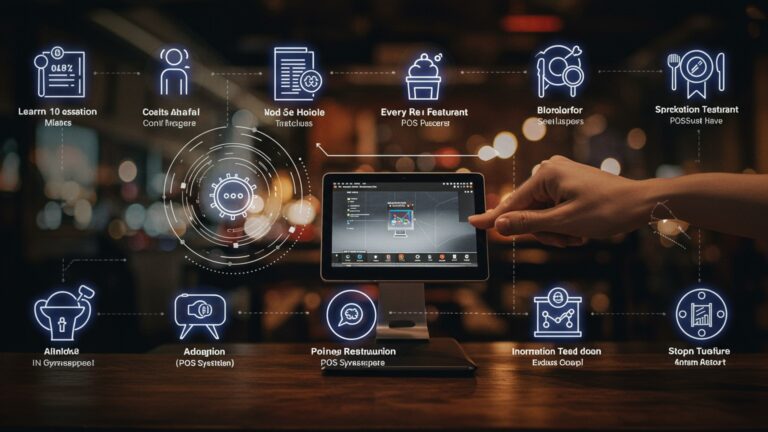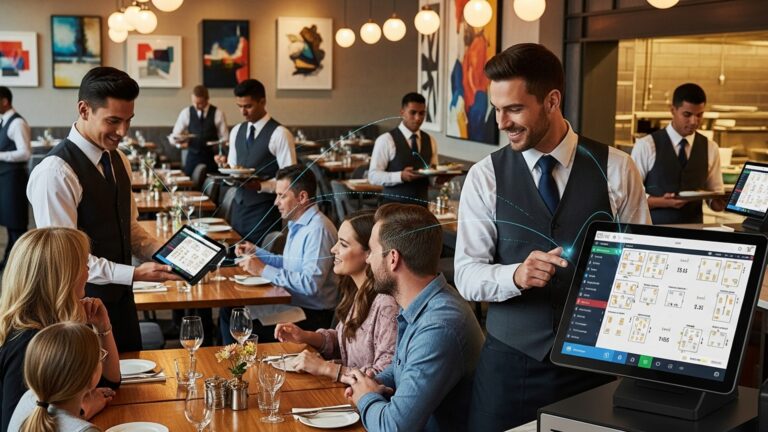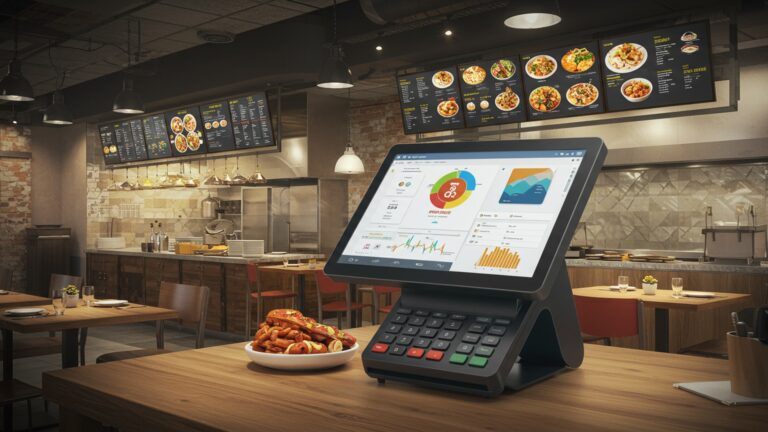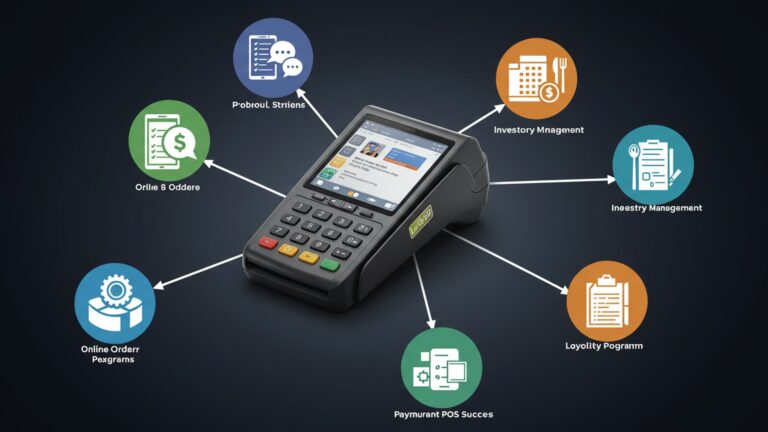How to Choose the Best POS Software to Streamline Your Sales
- pos software
- pos software

Understanding POS Software: The Core of Modern Retail
At its heart, Point of Sale (POS) software is the digital system that records sales transactions. Far beyond a simple cash register, modern POS software acts as the central hub for numerous business operations, integrating sales, inventory, customer management. reporting into one cohesive platform. It’s the engine that drives efficiency, provides crucial insights. ultimately, streamlines your sales process. For any business, from a bustling cafe to a multi-location retail chain, choosing the right POS software is paramount to operational success and growth.
Historically, a POS system was just a cash register and a receipt printer. Today, it encompasses sophisticated software running on various hardware (tablets, touchscreens, traditional terminals) that processes payments, tracks inventory in real-time, manages customer loyalty programs. generates detailed sales analytics. The evolution of POS software has transformed it from a mere transaction tool into a powerful business intelligence instrument.
Defining Your Business Needs: The Strategic Foundation
Before diving into the myriad of options available, the absolute first step is to thoroughly comprehend your own business’s unique requirements. This isn’t a one-size-fits-all solution; what works for a small boutique might cripple a busy restaurant. Consider the following:
- Industry Specifics: Are you in retail, hospitality, services, or e-commerce? Each industry has distinct needs. A restaurant, for instance, requires table management, kitchen display system (KDS) integration. menu modifiers, while a retail store prioritizes inventory tracking by size/color, barcode scanning. e-commerce sync.
- Business Size and Scale: A startup with one location will have different needs than an established enterprise with multiple branches. Small businesses might prioritize affordability and ease of use, while larger operations will need robust scalability, multi-location management. advanced reporting.
- Current Pain Points: What challenges are you currently facing? Is it slow checkout times, inaccurate inventory counts, difficulty tracking customer preferences, or cumbersome employee scheduling? Identifying these issues will help you prioritize features in your new POS software.
- Budget Constraints: Be realistic about what you can afford, not just for the software itself. also for hardware, installation, training. ongoing support.
For example, a small local bakery might need a basic system that efficiently processes orders, tracks ingredients. manages daily sales reports. In contrast, a growing clothing retail chain would require POS software capable of managing thousands of SKUs across multiple stores, integrating with an online store. providing detailed customer purchasing history for targeted marketing.
Essential Features to Look For in POS Software
The best POS software will offer a robust suite of features designed to simplify operations and enhance the customer experience. Here are the core components you should evaluate:
- Sales and Transaction Processing:
- Intuitive interface for quick order entry.
- Ability to process various payment types (cash, credit/debit cards, mobile payments, gift cards).
- Refunds, returns. exchanges management.
- Customizable discounts and promotions.
- Offline mode capability (crucial if your internet connection is unreliable).
- Inventory Management:
- Real-time tracking of stock levels.
- Automated reordering alerts.
- Barcode scanning and label printing.
- Multi-location inventory tracking.
- Variant management (size, color, style).
- Supplier management.
- Customer Relationship Management (CRM):
- Customer profiles with purchase history.
- Loyalty programs and rewards management.
- Email and SMS marketing integration.
- Ability to capture customer data for personalized marketing.
- Reporting and Analytics:
- Detailed sales reports (daily, weekly, monthly, by item, by employee).
- Inventory reports (stock levels, bestsellers, slow-movers).
- Customer reports (top spenders, purchasing trends).
- Employee performance reports.
- Customizable report generation.
- Employee Management:
- Time clock and shift management.
- Permissions and access levels for different roles.
- Performance tracking (sales per employee).
- Payment Processing Integration:
- Seamless integration with your chosen payment processor.
- Support for EMV chip cards and contactless payments.
- Secure transaction handling.
Cloud-Based vs. On-Premise POS Software: A Critical Comparison
One of the most significant decisions you’ll make is whether to opt for cloud-based (SaaS) or on-premise (locally installed) POS software. Each has distinct advantages and disadvantages:
| Feature | Cloud-Based POS Software (SaaS) | On-Premise POS Software |
|---|---|---|
| Data Storage | Data stored remotely on vendor’s servers; accessible via internet. | Data stored locally on your own servers and computers. |
| Cost Structure | Subscription-based (monthly/annual fees); lower upfront cost. | High upfront cost for software license and hardware; potential for lower long-term costs. |
| Accessibility | Access data and system from anywhere, any device with internet. | Typically limited to your business location; remote access requires complex setup. |
| Maintenance & Updates | Vendor handles all updates, security. maintenance automatically. | Your responsibility to manage updates, backups. security. |
| Scalability | Easily scalable; add/remove users or locations with subscription changes. | Scalability can be complex and require significant hardware/software upgrades. |
| Security | Vendor responsible for security, often with robust protocols; reliance on vendor’s practices. | You are solely responsible for data security; can be highly secure if managed well. |
| Offline Capability | Many offer an offline mode for continued operation during internet outages. | Generally operates without internet once installed. |
| Hardware Requirements | Often compatible with various hardware, including tablets (iPad, Android). | May require specific, more powerful hardware. |
Real-world application: A multi-location coffee chain, like “Daily Grind,” might find cloud-based POS software invaluable. Managers can monitor sales, inventory. employee performance across all branches from a single dashboard, even when traveling. Updates are pushed automatically, ensuring all locations are on the latest, most secure version. Conversely, a high-security jewelry store might prefer on-premise POS software for maximum control over their sensitive customer and inventory data, even with the added IT overhead.
Integration Capabilities: Building a Seamless Business Ecosystem
Modern businesses rarely operate with just one software solution. Your POS software needs to be a team player, integrating seamlessly with other critical business tools. Key integrations to look for include:
- E-commerce Platforms: If you sell online (Shopify, WooCommerce, Magento), your POS should sync inventory and sales data between your physical and online stores to prevent overselling and provide a unified customer experience.
- Accounting Software: Integration with platforms like QuickBooks, Xero, or Sage automatically transfers sales data, reducing manual data entry errors and saving countless hours during reconciliation. This is an absolute game-changer for financial accuracy.
- Payment Processors: While some POS systems have proprietary payment processing, many integrate with third-party providers. Ensure your chosen POS software supports your preferred processor or offers competitive rates through its partners.
- Marketing Tools: Connect with email marketing platforms (Mailchimp, Constant Contact) or SMS services to leverage customer data for targeted campaigns.
- Third-Party Delivery Services: For restaurants, integration with services like DoorDash, Uber Eats, or Grubhub can streamline order management, pushing online orders directly to your KDS.
Consider the case of “The Green Thumb Nursery,” a local plant shop. Their chosen POS software integrates with their Shopify e-commerce store, ensuring that an indoor fern sold in-store is immediately removed from online inventory. It also syncs daily sales with QuickBooks, making monthly financial reporting a breeze. This interconnectedness is a hallmark of truly effective POS software.
Scalability and Future-Proofing Your Investment
Your business today might not be your business tomorrow. The best POS software is one that can grow with you. Ask potential vendors:
- Can the system easily add more users, terminals, or locations as my business expands?
- Does it support additional modules or features I might need in the future (e. g. , advanced analytics, loyalty programs, specific industry tools)?
- How frequently is the software updated. what is the vendor’s roadmap for new features and improvements?
- Is the hardware flexible? Can I use existing hardware, or am I locked into proprietary equipment?
Investing in scalable POS software means you won’t have to go through the disruptive and costly process of switching systems every few years. It’s about making a long-term strategic decision.
Security and Compliance: Protecting Your Business and Customers
In an age of constant cyber threats, the security of your POS software is non-negotiable. You are handling sensitive customer data and financial transactions. Ensure the POS software adheres to industry standards, especially Payment Card Industry Data Security Standard (PCI DSS) compliance. Key security features include:
- Encryption: All transaction data should be encrypted both in transit and at rest.
- Tokenization: Sensitive cardholder data should be replaced with a unique, non-sensitive token.
- User Access Controls: Granular permissions to restrict what employees can access or modify.
- Regular Updates and Patches: The vendor should regularly release security updates to address vulnerabilities.
- Data Backup and Recovery: Robust backup systems are essential to prevent data loss. For cloud-based systems, inquire about their disaster recovery protocols.
A data breach can be devastating, leading to financial losses, reputational damage. legal repercussions. Prioritize a vendor with a strong track record and transparent security policies for their POS software.
Cost Considerations: Looking Beyond the Sticker Price
The total cost of ownership (TCO) for POS software goes beyond the initial price. You need to factor in several components:
- Software Licensing/Subscription: One-time purchase for on-premise or recurring fees for cloud-based.
- Hardware Costs: Terminals, barcode scanners, receipt printers, cash drawers, customer displays. Some vendors offer bundles; others require you to purchase compatible hardware separately.
- Payment Processing Fees: These are often a significant ongoing cost. Compare rates from different providers or integrated options. Look out for hidden fees or long-term contracts.
- Installation and Setup: Will you need professional help, or can you do it yourself?
- Training: Is training included, or is there an additional cost?
- Ongoing Support: What kind of support is offered (24/7, email, phone) and at what cost?
- Integration Costs: Some integrations might incur additional fees.
A common mistake is choosing the cheapest upfront option only to find exorbitant transaction fees or inadequate support down the line. Always request a detailed breakdown of all potential costs.
Testing and Implementation: Making the Switch Smoothly
Once you’ve narrowed down your choices, don’t commit without a thorough trial. Most reputable POS software providers offer free demos or trial periods. Use this time to:
- Test all core functionalities: Process sales, manage inventory, run reports, handle returns.
- Involve your team: Get feedback from the employees who will be using the system daily. Their insights are invaluable.
- Check hardware compatibility: Ensure your existing hardware works, or test the vendor’s recommended hardware.
- Evaluate customer support: Test their responsiveness and helpfulness during your trial.
When it’s time to implement, plan for a smooth transition. This often involves data migration (importing existing inventory, customer lists), thorough staff training. a phased rollout if possible. A well-executed implementation minimizes disruption and maximizes the benefits of your new POS software.
Conclusion
Choosing the right POS software is more than a technical decision; it’s a strategic move to future-proof your sales operations. My personal tip, honed from years of observing retail transformations, is to prioritize hands-on demos. Don’t just read reviews; actively test how a system like Square or Shopify POS handles a complex return or a multi-item sale. This reveals its true user-friendliness, a critical current trend. Crucially, assess its integration capabilities – can it seamlessly connect with your e-commerce platform or accounting software? This prevents data silos, a common modern business headache. Ultimately, invest in a solution that offers real-time data insights, like those leveraging AI for predictive sales analytics, ensuring you’re not just processing transactions but strategically growing your business. Empower your team with an intuitive system. watch your sales flow effortlessly. For more insights on current retail technology, consider exploring resources like the Retail Dive Technology section.
More Articles
Mastering Cloud Based POS Software How to Boost Your Business Efficiency
How to Select the Perfect POS Software for Your Retail Business Needs
How to Implement POS Software for Your Grocery Store A Complete Guide
How to Select the Perfect POS Billing Software for Your Business
How to Set Up Cloud Based POS Software for Business Growth
FAQs
What’s the big deal with POS software anyway?
POS, or Point-of-Sale, software is essentially the heart of your sales operations. It’s what processes transactions. modern systems do so much more. They help you manage inventory, track sales data, interpret customer behavior. generally make your business run smoother and faster, leading to better profits and happier customers.
Why should my business bother with POS software?
It’s about efficiency and insight. Good POS software automates tasks like inventory updates, speeds up checkout times, reduces human error. gives you invaluable reports on your sales performance. This means less wasted time, better stock management. smarter business decisions based on real data, rather than guesswork.
What key features should I look for in POS software?
Beyond just processing payments, essential features include robust inventory management (tracking stock, variants, low stock alerts), detailed sales reporting and analytics, customer relationship management (CRM) tools, employee management (time clocks, permissions). multi-location support if you have more than one store. Don’t forget seamless integration with payment processors!
How do I know if it’ll integrate with my other business systems?
Integration is super vital for a streamlined workflow. You’ll want to check if the POS software can connect with your accounting software (like QuickBooks or Xero), e-commerce platform (Shopify, WooCommerce), or any existing CRM you use. Look for systems that offer open APIs or have pre-built integrations with popular tools. Always ask the vendor specifically about the integrations you need.
Should I go for cloud-based or on-premise POS?
Cloud-based (SaaS) systems are generally more popular now. They’re accessible from anywhere, often have lower upfront costs. updates are handled by the provider. On-premise solutions give you more control over your data and hardware. require more IT expertise and higher initial investment. For most small to medium businesses looking for flexibility and ease of use, cloud-based is usually the way to go.
Is it easy for my team to learn and use?
User-friendliness is crucial. A complex system can slow down transactions and frustrate staff. Look for intuitive interfaces, logical workflows. minimal clicks to complete common tasks. Many providers offer free trials or demos, which are great opportunities to let your team test it out and get their feedback before committing.
What about ongoing support and future updates?
Don’t underestimate the importance of good customer support. You’ll want access to reliable help when things go wrong, whether it’s 24/7 phone support, email, or a comprehensive knowledge base. Also, ensure the provider regularly releases updates with new features and security patches, showing they’re committed to improving their product and keeping it secure.





